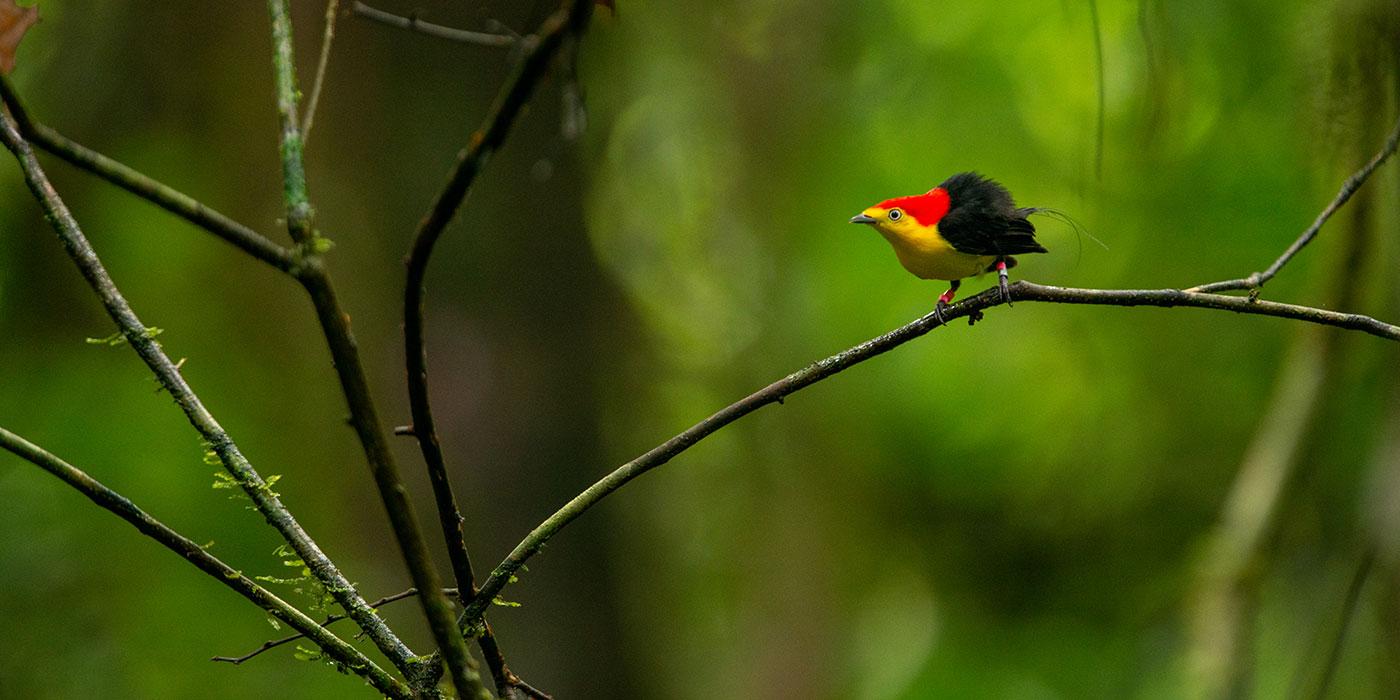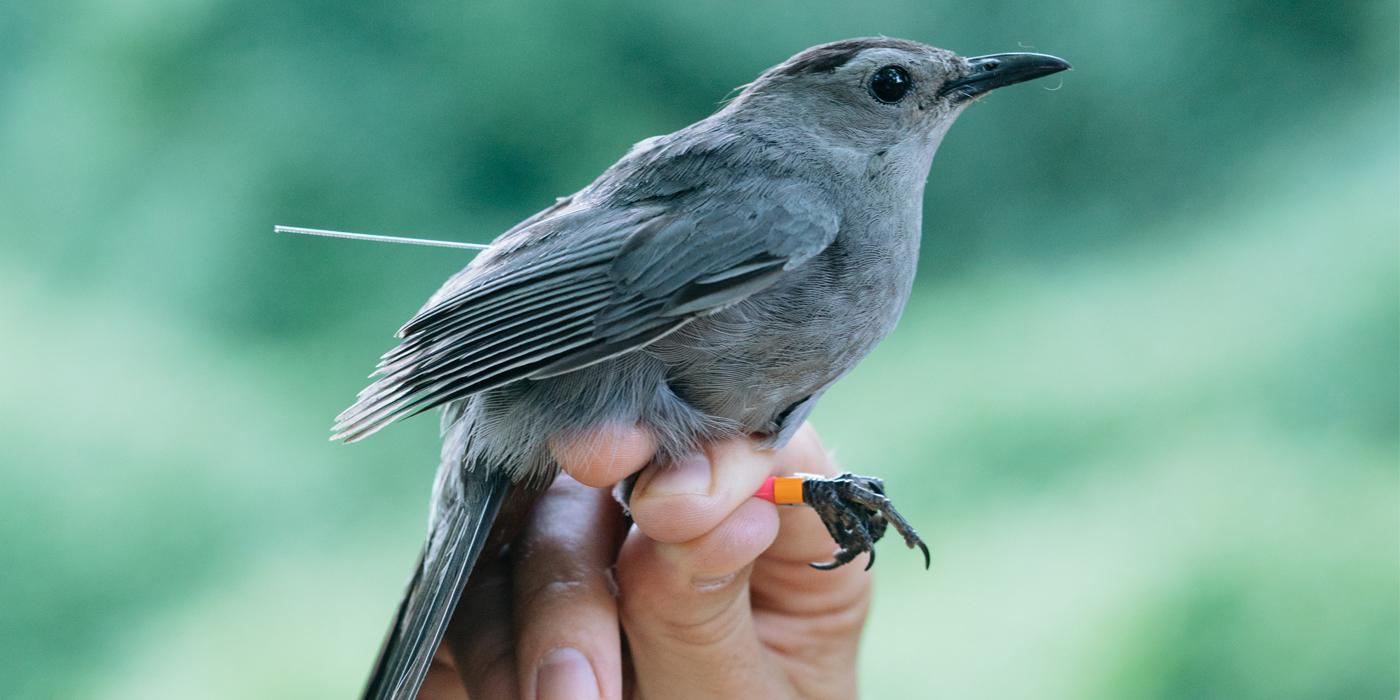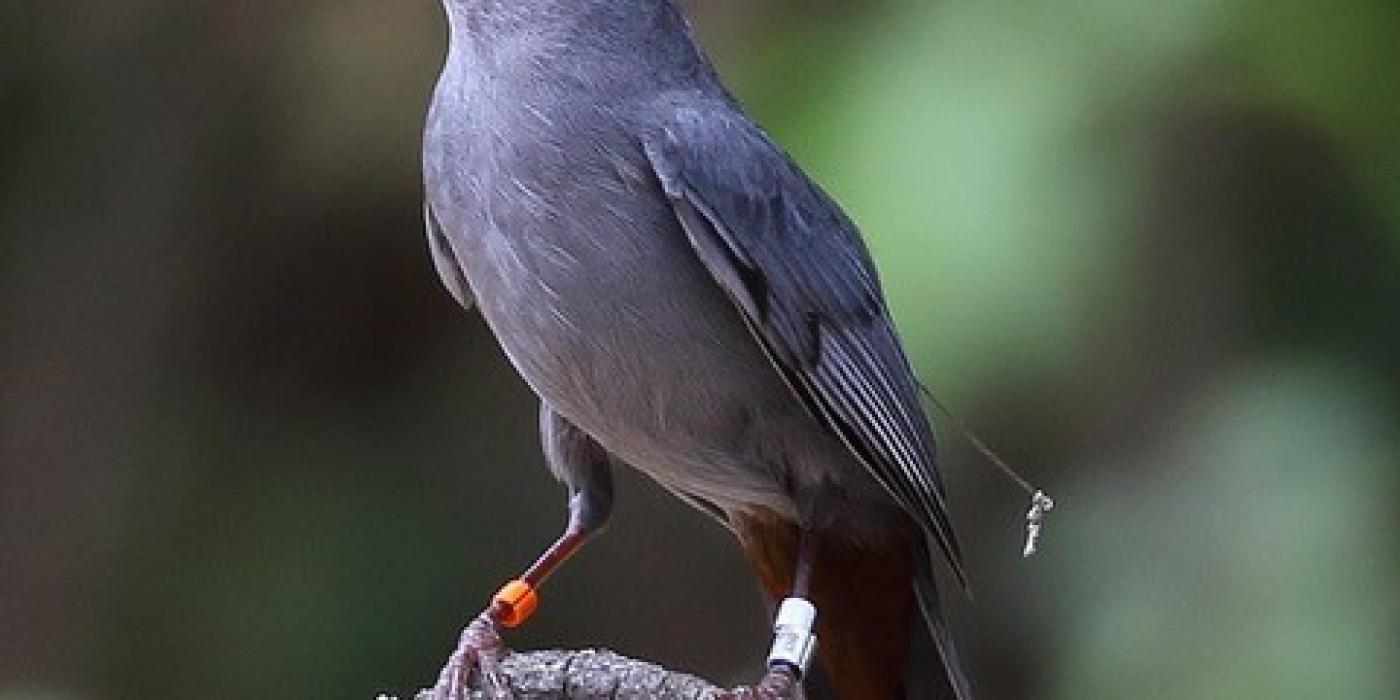Wire-tailed Manakin Expedition Blog
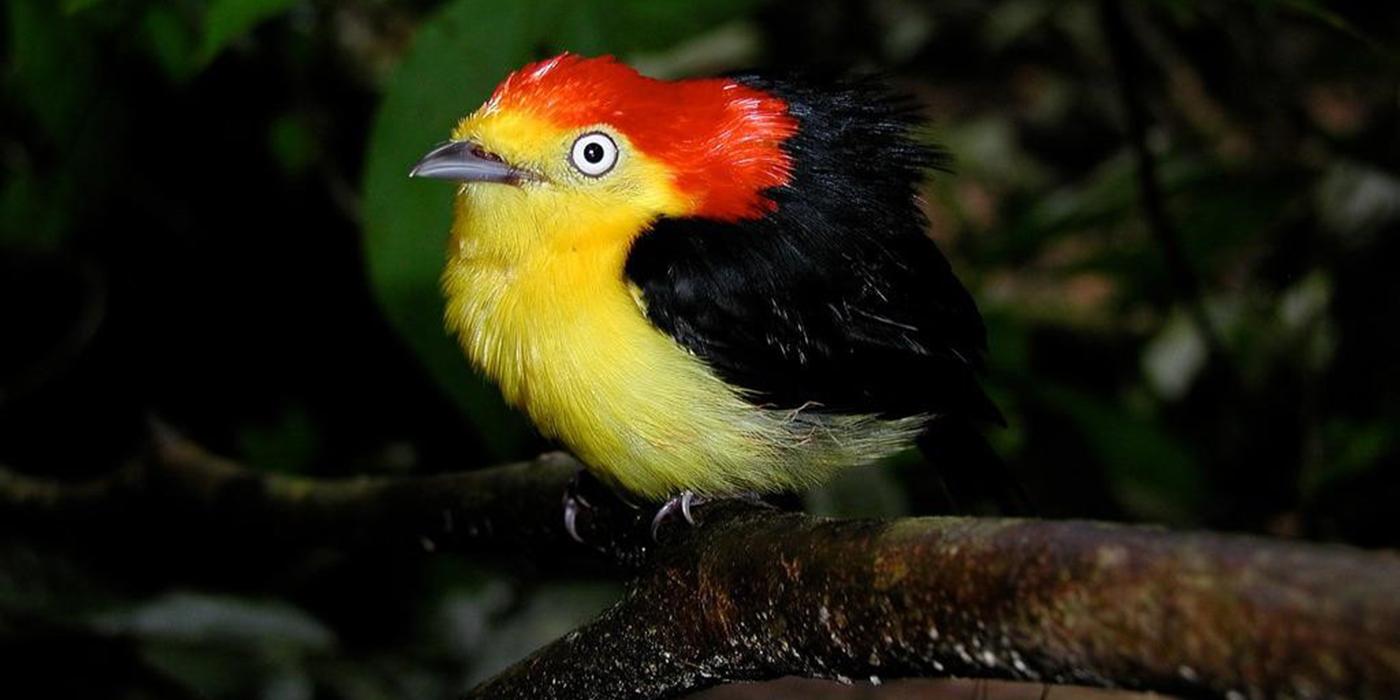
The Curious Case of the Wire-tailed Manakin
The wire-tailed manakin is a strange bird. In your typical species, each male defends his territory against all intruders.
Male manakins, in contrast, actually benefit from having other males on their territories, because these visitors join them in dancing to attract females. Such "floater" males cruise around the rainforest and dance with this territory owner here, that territory owner there…
It sounds like fun, but it's an evolutionary puzzle: females that watch such a display mate with the territory owner rather than the floater. So how do floater males pass on the genes that encode such a footloose and fancy-free existence? Why don't floaters seize any opportunity to set up a territory and begin trying to attract females themselves?
Being a territory owner doesn't look particularly strenuous, and males don't help the females take care of the eggs or the chicks, so getting a territory of one's own seems like the best evolutionary strategy. Yet we see floater males in the population even when good territories are unoccupied. Work by my postdoctoral supervisor, Brandt Ryder, suggests that floaters are investing in the future by building a social network with other males, and that this network may be necessary to succeed in occupying a territory and attracting females.
As a sperm biologist, I wonder if there is also a dark underside to this story, if these floater males cheat the system and pass along some genes as they climb the social ladder. There are several species of fishes where females chose territorial males to fertilize their eggs, and non-territorial males sneak in between such spawning pairs to add their sperm to the mix (fertilization happens outside the female body in these species). Could there be something analogous going on in manakins?
Probably not sneaking in (that seems difficult for an internally-fertilizing species!), but floater males could devote a lot of physiological resources to sperm production, so that they have a high chance of fertilizing eggs if they manage to copulate with a female. After 5 weeks of catching and sampling manakins, Brandt and I have enough data to start examining this possibility. It may be that manakins are even stranger than they first appeared!
Unfamiliar Amazon
Unfamiliarity has made my first two weeks in the Amazon a bit intimidating. As a somewhat timid Marylander, I'm used to patches of woods interspersed with fields and houses. In contrast, this forest is seemingly endless and so dense that I only really see the sky when I'm on the river.
Hiking to the field sites in the pre-dawn darkness, the curled, dried leaves of Cecropia trees that lie in my path transform into venomous fer-de-lances coiled to strike. When I reach out to steady myself on steep, slippery sections of trail, I worry about a multitude of unpleasant creatures and plants that I might inadvertently grab. I think about the early European explorers in this region, working without an LED headlamp, without a steady supply of clean drinking water, without the safety net of a GPS unit in case they got turned around in the forest. It must have been terrifying.
But the unfamiliar is also entrancing. Take, for instance, the wire-tailed manakins we study. Male wire-tailed manakins dance with each other to attract females, appearing almost clown-like with their bright yellow undersides, red heads, wide-open white eyes, and fast, jerky movements. I find the dance stage particularly charming: the males have favored perches, and they wear those perches smooth with their tiny little bird feet. How many dances must it take for a bird that weighs less than 3 nickels to polish a perch?
Buttressed trees are another favorite. A big tree can have buttresses starting 10 feet up the trunk, radiating away from the tree in graceful, sinuous curves and glowing in dappled afternoon sunlight. They resonate hollowly when tapped, and they provide a roosting place for bats, a growing surface for lichens and small plants, and a hiding spot for snakes, sand flies, and all sorts of things.
And in with all the new sights and experiences, there are splashes of familiarity as well. One morning we watched a mixed-species flock moving through the canopy and found a scarlet tanager looking surprisingly at home alongside the gilded barbet, flame-crested tanager, opal-crowned tanager, chestnut-shouldered antwren, and others. In mist nets intended for manakins, we find Swainson's thrushes.
Both the scarlet tanager and the thrushes are here for the northern winter, and seeing them is a strong reminder of how connected life is across our planet. Our actions back in the United States affect the birds here and vice versa—so even though this place feels new and different to me, it's not really so far removed from home.
Amazon Introduction
This is my first time in the Amazon. We are headed to the Tiputini Biodiversity Station, where I'll spend 5 weeks studying the social behaviors and physiology of the wire-tailed manakin.
Together with Brandt Ryder, the manakin project leader, and a group of high schoolers headed for a short study abroad, I clamber down a steep slope with my heavy backpack and climb into a long, narrow boat.
It is our second boat ride of the day; the first was on the broad Rio Napo, zigzagging back and forth to avoid sand bars and submerged logs, the driver taking occasional tips from the guide at the front of the boat, but mostly showing uncanny skill at spotting the hazards himself. After the Napo and a 1.5 hour open-air bus ride, we are now at the narrower Rio Tiputini, where it's easier to see the wildlife we're passing.
Blue morpho butterflies glisten, startlingly metallic, as they meander across the river. A great potoo pretends to be just another snag on the dead tree reaching into the river, and anhingas carefully track the progress of our passing boat with their snaky necks and wicked-looking bills. Tantalizing glimpses of other birds flash past too quickly for me to identify them, and I look forward to exploring this place at a slower pace.
In the late afternoon, we finally reach our goal, perched above a bend in the river. Though I've done fieldwork in many places before, I'm a little bit nervous—will I be able to handle the heat, humidity, and isolation from the outside world? Will my eyes be quick enough to track the ultra-fast manakins as they zip around the forest? Will the ants, wasps, spiders, and mosquitoes be too much for me? (Somehow biodiversity is less appealing when it is biting, stinging, or sucking your blood!)
But for this afternoon, I take a deep breath, sit on the river dock, and watch a troop howler monkeys moving with perfect ease along vines in the forest. Across the river, a particularly large tree emerges from the canopy, its branches dripping with bromeliads and other epiphytes—a whole ecosystem in itself. A scarlet macaw flies over the river, the reddish sunset light helping the bird live up to its name. I am in the Amazon. It is awesome.
Ryder Expedition Post
Many researchers and bird enthusiasts alike consider John James Audubon to be one of the founding fathers of ornithology. As the pioneer of early studies on birds, Audubon developed one of the most important methodological tools for studying birds—banding. In 1803, he tied a small piece of ribbon to a bird leg so that he could identify individuals when re-sighted at a later point. Since that aha moment, ornithologists have used a myriad of approaches, to advance our understanding of the behavior and population dynamics of these otherwise elusive organisms.
Advancing scientific understanding often requires employing and outside the box approach. Sometimes this even means being the guinea pig for testing innovative techniques. In my last Expedition Blog post, I described how the Smithsonian Migratory Bird Center is often at the forefront of using technology to test the boundaries of scientific discovery. Here in the Amazon we are harnessing new data collection techniques to give us an unprecedented look into the secretive lives these birds lead when no one is watching. Tracking the interactions of birds in the rainforest can be exceeding difficult. While extremely colorful, these birds are small (about the size of a chicken egg), move quickly, and like to stay hidden.
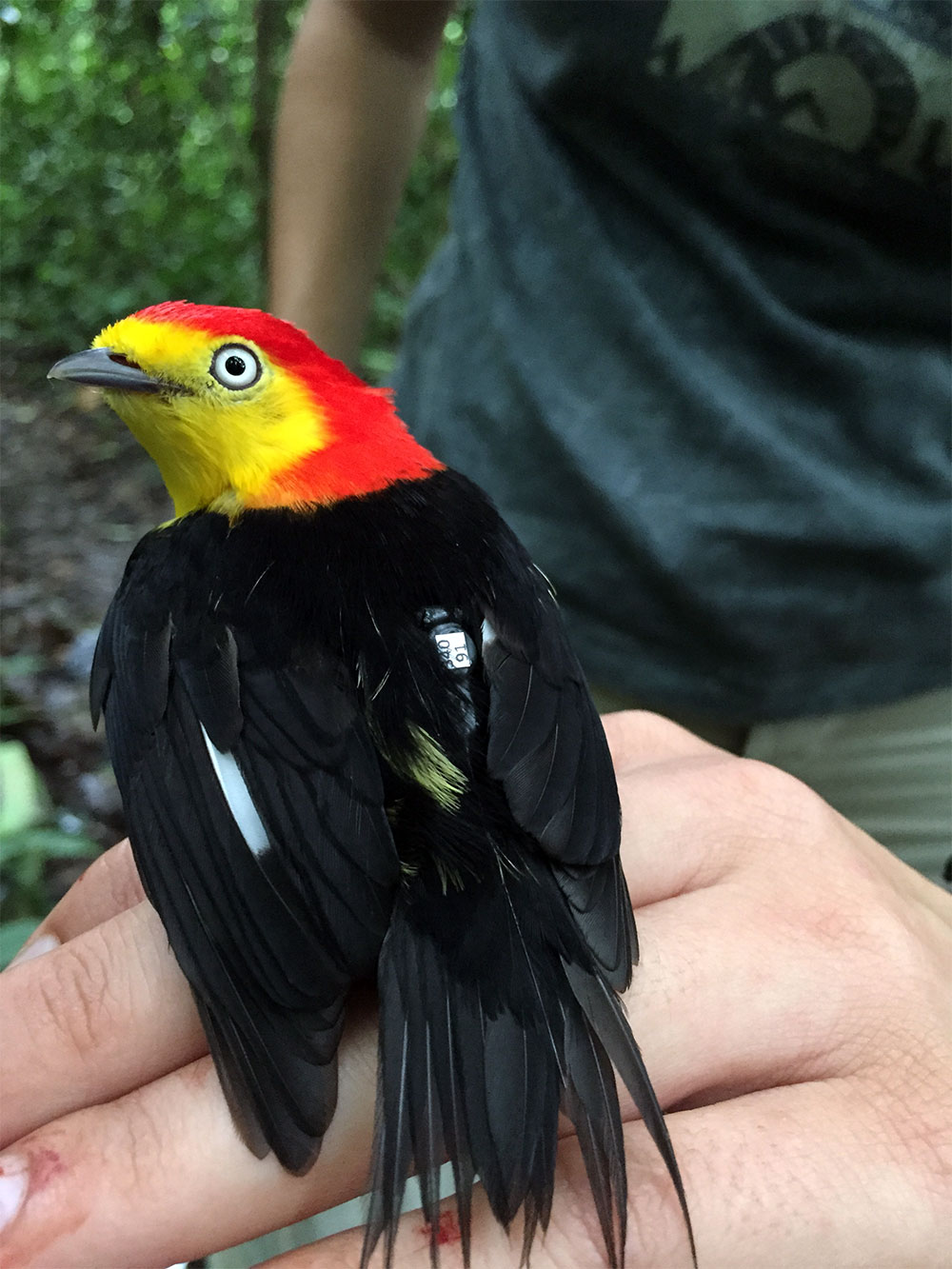
An adult Wire-tailed manakin fitted with a coded nano tag.
To help us overcome these challenges we fit each individual with a tag that has a unique ID likened to a bird social security number—not so different than Audubon's initial way of tagging individuals within a population—but this time the tag transmits a signal. Then, we place fixed receivers in the forest that detect tagged males in a 300-400 foot radius as they move about their daily activities and interact with other males. This information provides us detailed information about how and with whom these birds spend their time. The hope is to link these patterns with information about individual variation in hormones and to better understand the physiological underpinnings of a complex behavior pattern.
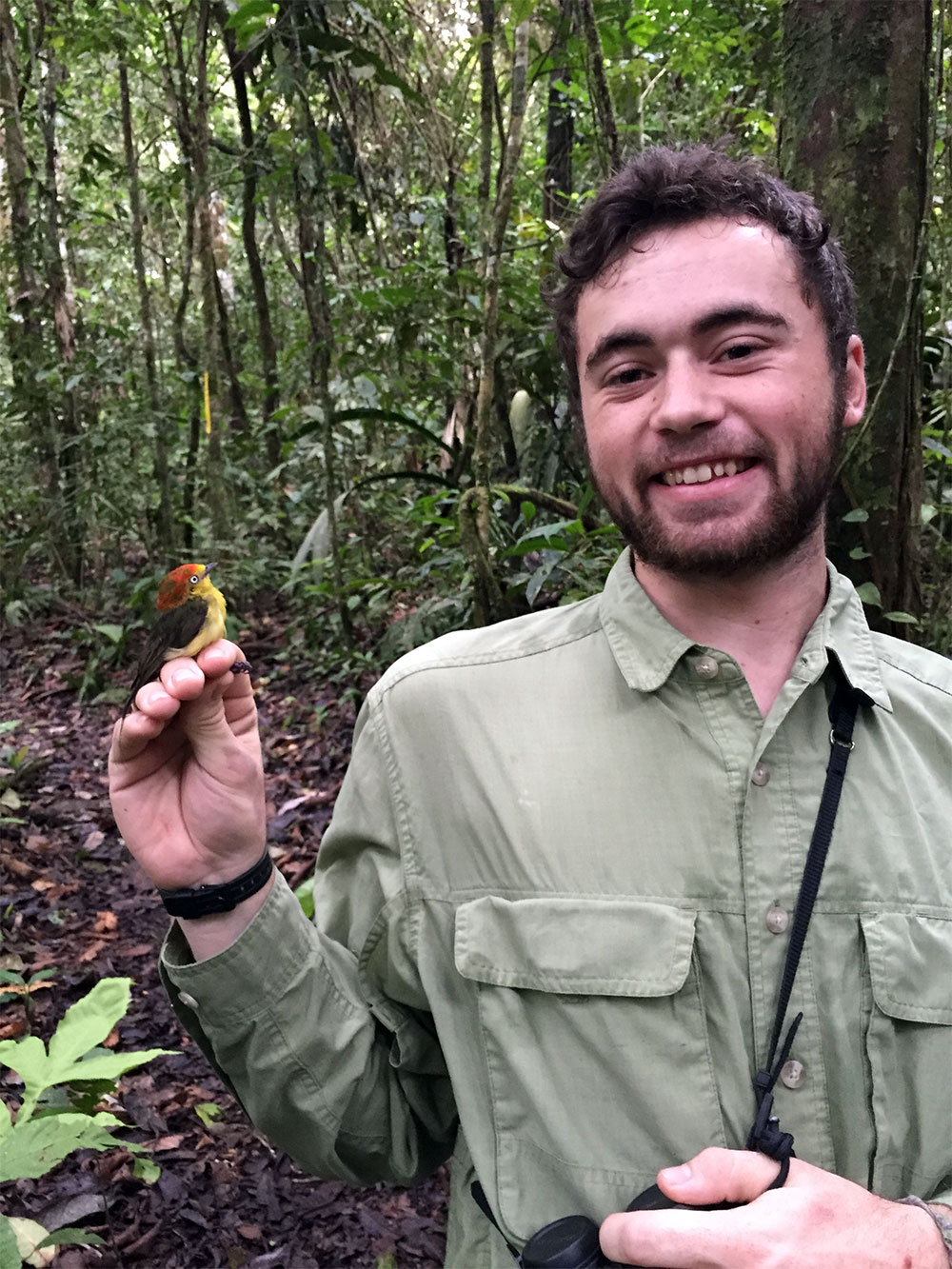
SMBC graduate student Ben Vernasco holds an immature male manakin in pre-definitive plumage.
In the first three weeks of the field season we deployed nearly 100 tags! While it sounds simple enough, capturing these birds takes time, careful planning and lots of people power. Most of the capture locations are only reached after two hours of hiking on muddy trails. Most days, we get started around 4 a.m. to trek through tangled thickets and splash through overflowing streams.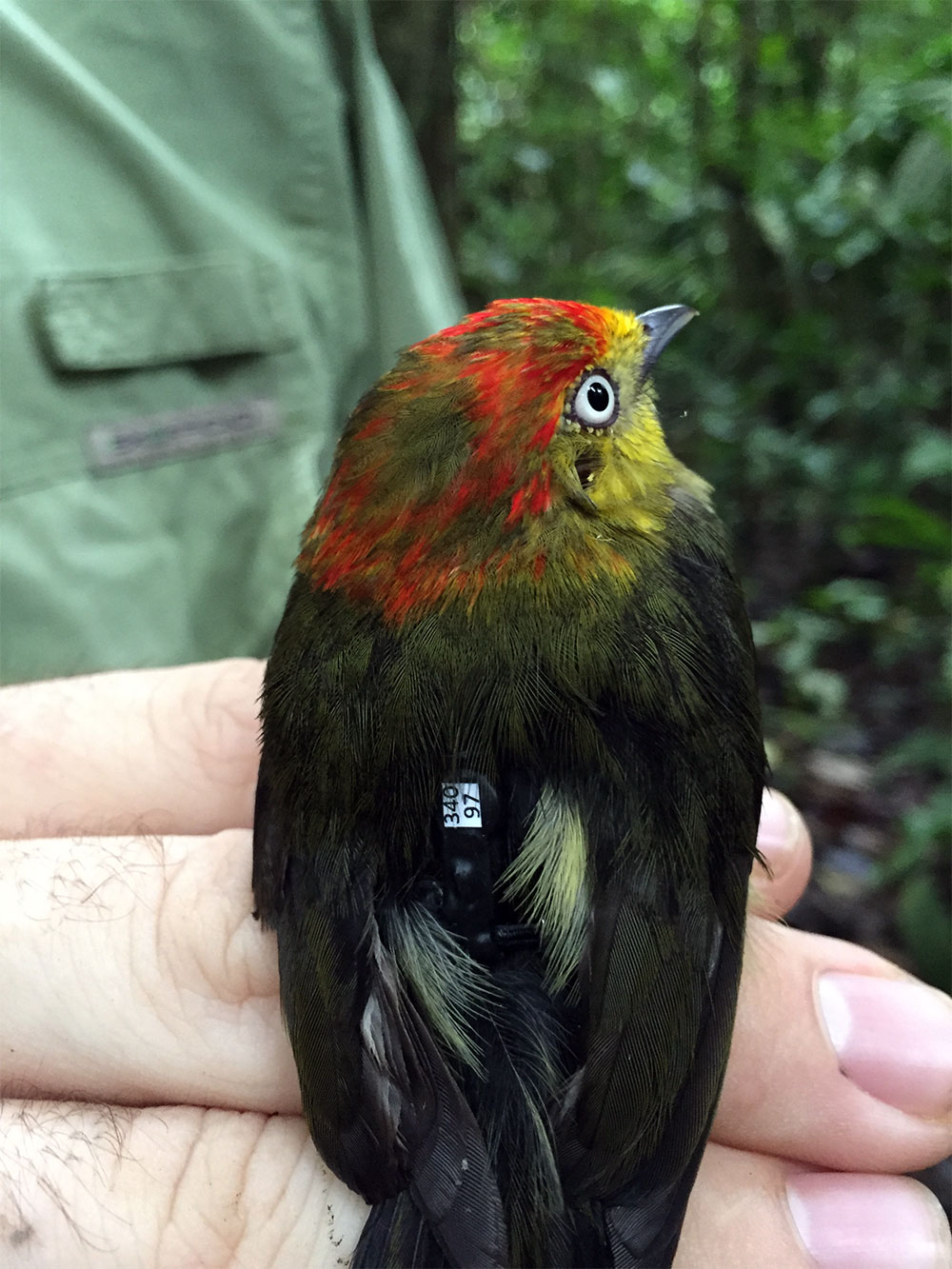
An immature male manakin with coded tag.
Good rain boots are an essential piece of field equipment. These efforts have payoffs, too. One lucky morning, we encounter a mother tapir and her baby along the trail. In Washington, D.C. traffic, stoplights, and NPR on the radio characterizes my commute; in the rainforest I get to enjoy marching along to a symphony of cicadas, katydids, tree frogs, curassows and howler monkeys.
More than two centuries after Audubon used a ribbon to track the movement of birds we are using 0.35 gram tracking devices (one third the weight of a penny) to push the boundaries of scientific discovery. Who knows what's next, but undoubtedly new tools and technologies will play a key role as we aim to protect and conserve the most biologically diverse places on the planet.
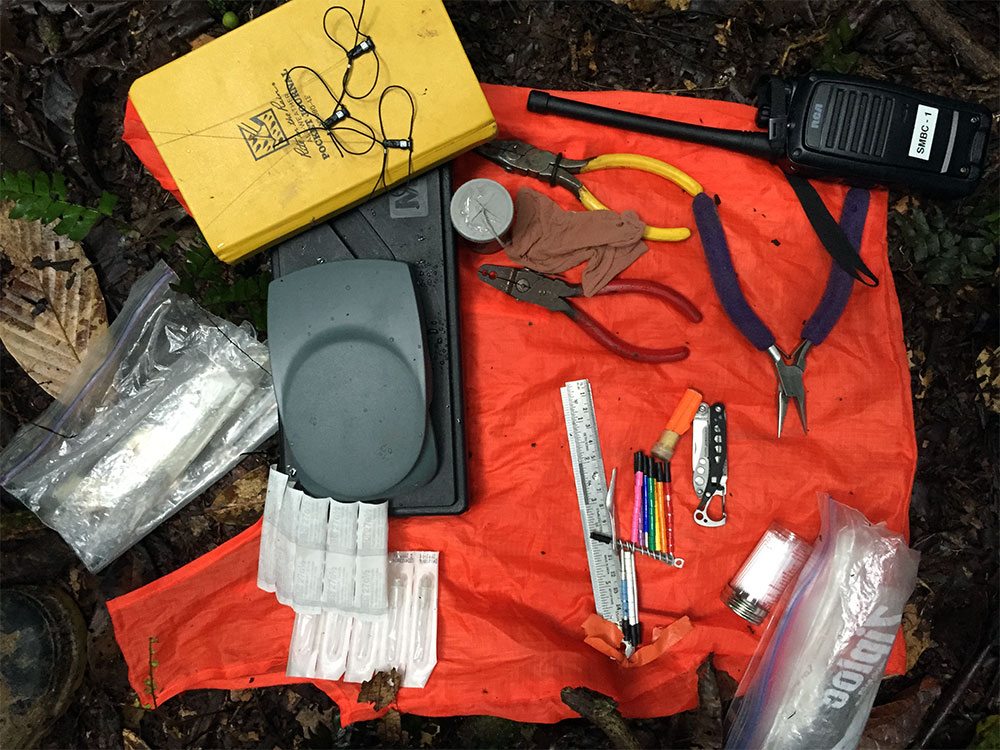
Dancing Birds and Swinging Monkeys
The tropical rainforest of Central and South America have been wrapped in mystique since the early days of scientific exploration. Pioneering naturalists and biologists marveled when they first encountering these hyper-diverse ecosystems often describing the vegetation as verdant walls of impenetrable green. It was these locations and their diversity of life that spawned the ponderings of Darwin and Wallace's theory of evolution.

For the last 13 years I have been lucky to have the opportunity to work in the Ecuadorian Amazon conducting ornithological research. These trips happen to coincide with winter in my East Coast home and my family often jokes that I migrate along with most of our temperate feathered friends. Traveling in the Amazon is its own adventure, requiring a dizzying array of plane and boat rides, followed by a bumpy truck trip before finally arriving at my study site in a dugout canoe.
So this holiday season, like many before, I find myself lulled to sleep by buzzing cicadas rather than Christmas carols or Auld Lang Syne. We are here studying a small fruit eating bird called the wire-tailed manakin. These bizarre little creatures spend their days doing acrobatic aerial displays, dance moves reminiscent of the disco kings of the seventies. Wire-tailed manakins are unique because males form partnerships to attract mates. They are the most literal and figurative example of wingmen! To understand these cooperative relationships I am working with a team of scientists to link hormones to social networks (very much like our own friendship networks on Facebook).
Part of understanding the complexity of animal movement and behavior requires thinking outside the box. At the Migratory Bird Center we pride ourselves with applying the latest and greatest technology to track long distance migration. We also use these technologies to learn about the intricacies of social behavior. Here in Ecuador, manakins are fitted with small nano tags that can monitor social interactions and movement.
While our work is just getting off the ground, we are excited to share our stories of dancing birds, swinging monkeys, slithering snakes and verdant walls of impenetrable vegetation. I feel proud to follow in the footsteps of Darwin and Wallace with the knowledge that our research will contribute to the James Smithson's vision to increase and diffuse knowledge.
Wire-tailed Manakin Study
Studies have begun in the Yasuni National Park, thought to be the most biodiverse habitat on the planet, on the wire-tailed manakin. The park is located in a remote area of Ecuador in the Amazonian rainforest.
The wire-tailed manakin is a cooperate, lek-breeding bird. This study will integrate behavioral ecology, neuroendocrinology, and molecular genetics and combine descriptive studies (natural variation in hormones, behavior, and neuroendocrine gene expression), experimentation (phenotypic engineering, hormone challenges, and social intrusions), and novel social networking approaches (proximity data-logging).
Map of study site. Selecting the red icon displays a picture of the study area in the Amazonian forest.
NSF Proposal Funded
Smithsonian Migratory Research Center scientist Brandt Ryder, along with colleagues from Virginia Tech, will receive funding from the National Science Foundation for a research project "Understanding how a hormone-signaling pathway modulates behavioral phenotype within a social network".
Overview: Hormone regulatory networks are essential for the development of complex phenotypes, and these whole-organism outcomes scale up to affect behavioral interactions and subsequent higher order social network structure. To date, no study has concurrently examined the proximate links between individual variation in hormone-signaling pathways, behavioral phenotype and social network structure. Here, we aim to fill this gap in knowledge by examining a hormone-signaling pathway thought to underlie variation in social behavior and subsequent network structure in a cooperative lek-breeding bird, the wire-tailed manakin (Pipra filicauda).
We use an evolutionary framework to ask two primary research questions:
- How does individual variation in the hormone-signaling pathway shape behavioral phenotype, and
- How does individual variation in behavioral phenotype scale up to affect social network structure?
To answer these questions, we will integrate behavioral ecology, neuroendocrinology, and molecular genetics in a comprehensive field study of a unique and promising organism. The research will combine descriptive studies (natural variation in hormones, behavior, and neuroendocrine gene expression), experimentation (phenotypic engineering, hormone challenges, and social intrusions), and novel social networking approaches (proximity data-logging).
